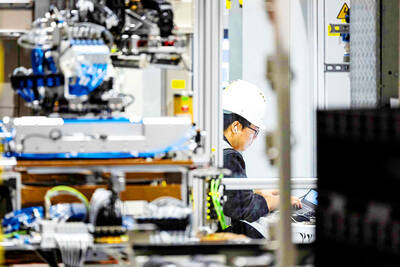A self-driving hybrid vehicle made by the Mobility Taiwan Automotive Research Consortium (mTARC, 台灣車輛移動研發聯盟) is to operate at Hsinchu’s Nanliao Harbor (南寮漁港) after being granted a license, the Industrial Technology Research Institute (ITRI, 工研院) said at an exhibition in Taipei yesterday.
Hsinchu Mayor Lin Chih-chien (林智堅) signed a memorandum of understanding with ITRI to allow the institute to test its self-driving vehicles in the city.
The institute said that it hopes the test could help improve the vehicles’ functions and safety systems.
“We want Hsinchu to be Taiwan’s first testing ground for self-driving cars, because we have a strong talent pool in the region,” Lin said.
Earlier this month, Lin said he hoped self-driving vehicles could be used to ease traffic jams in the city.
The main theme of mTARC’s exhibition this year is “intelligent mobility, connectivity and sharing.”
The consortium added “mobility” to its name this year, Ministry of Economic Affairs Department of Industrial Technology Director-General Lo Ta-sheng (羅達生) told a news conference yesterday.
Larry Chang (張念慈), director of ITRI’s Mechanical and Mechatronics Systems Research Labs, said that the autonomous vehicle is still being tested.
The institute has tested its self-driving vehicles in the Changhua Coastal Industrial Park (彰濱工業區) for three years, accumulating total mileage of more than 2,000km, he said.
Nanliao Harbor has sufficient roads and infrastructure for driving tests, Chang added.
The self-driving programs for a Luxgen Motor Co (納智捷) fossil-fuel car, designed by the Automotive Research & Testing Center (ARTC, 車輛研究測試中心), and a Chrysler hybrid car, designed by ITRI, are to be tested at Nanliao, Chang said.
ARTC is also developing electric shuttle buses, center researcher Tsai Hung-yih (蔡汯嶧) said.
mTARC develops autonomous driving for hybrid cars, fossil-fuel cars and electric buses to target different customers, he said.
“mTARC is a platform for various institutions to share technology and seek different possibilities,” Tsai added.
At the exhibition, the consortium displayed 23 research results in self-driving technology, such as sensors and thermographic cameras that locate and show pedestrians in all kinds of weather, image recognition systems that can distinguish objects on the road, intelligent LED headlights that can automatically avoid creating glare for oncoming drivers, sensors that can detect a driver’s status and an alarm system that warns a driver of obstacles in their blind spots.
Cameras and sensors installed in the self-driving vehicle collect and send data, which could be analyzed to show road status, traffic flow, parking lot status and pedestrian flow, Chang said.
Lin was presented a smartphone app that could start the engine of mTARC’s self-driving vehicle outside the exhibition hall.
The vehicle’s passenger safely exited the vehicle after sitting in the back seat for a few minutes.
The products displayed by mTARC are the result of research by the Chungshan Institute of Science and Technology, the Institute for Information Industry (資策會), ITRI, ARTC, the Metal Industries Research and Development Center (金屬工業研究發展中心), the Hua-Chuang Automobile Information Technical Center Co Ltd (華創車電技術中心) and 16 companies.

CHIP RACE: Three years of overbroad export controls drove foreign competitors to pursue their own AI chips, and ‘cost US taxpayers billions of dollars,’ Nvidia said China has figured out the US strategy for allowing it to buy Nvidia Corp’s H200s and is rejecting the artificial intelligence (AI) chip in favor of domestically developed semiconductors, White House AI adviser David Sacks said, citing news reports. US President Donald Trump on Monday said that he would allow shipments of Nvidia’s H200 chips to China, part of an administration effort backed by Sacks to challenge Chinese tech champions such as Huawei Technologies Co (華為) by bringing US competition to their home market. On Friday, Sacks signaled that he was uncertain about whether that approach would work. “They’re rejecting our chips,” Sacks

It is challenging to build infrastructure in much of Europe. Constrained budgets and polarized politics tend to undermine long-term projects, forcing officials to react to emergencies rather than plan for the future. Not in Austria. Today, the country is to officially open its Koralmbahn tunnel, the 5.9 billion euro (US$6.9 billion) centerpiece of a groundbreaking new railway that will eventually run from Poland’s Baltic coast to the Adriatic Sea, transforming travel within Austria and positioning the Alpine nation at the forefront of logistics in Europe. “It is Austria’s biggest socio-economic experiment in over a century,” said Eric Kirschner, an economist at Graz-based Joanneum

BUBBLE? Only a handful of companies are seeing rapid revenue growth and higher valuations, and it is not enough to call the AI trend a transformation, an analyst said Artificial intelligence (AI) is entering a more challenging phase next year as companies move beyond experimentation and begin demanding clear financial returns from a technology that has delivered big gains to only a small group of early adopters, PricewaterhouseCoopers (PwC) Taiwan said yesterday. Most organizations have been able to justify AI investments through cost recovery or modest efficiency gains, but few have achieved meaningful revenue growth or long-term competitive advantage, the consultancy said in its 2026 AI Business Predictions report. This growing performance gap is forcing executives to reconsider how AI is deployed across their organizations, it said. “Many companies

France is developing domestic production of electric vehicle (EV) batteries with an eye on industrial independence, but Asian experts are proving key in launching operations. In the Verkor factory outside the northern city of Dunkirk, which was inaugurated on Thursday, foreign specialists, notably from South Korea and Malaysia, are training the local staff. Verkor is the third battery gigafactory to open in northern France in a region that has become known as “Battery Valley.” At the Automotive Energy Supply Corp (AESC) factory near the city of Douai, where production has been under way for several months, Chinese engineers and technicians supervise French recruits. “They